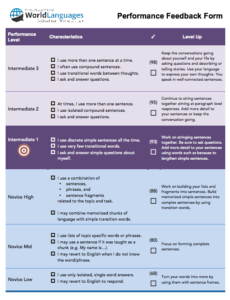Feedback is critical to any learning endeavor but I would pose that more important than feedback is to feed forward. It is one thing to tell learners what they did right and what they did wrong. We do that rather naturally because that is what any graded paper tells students. All too often though those papers or rubrics end up on the floor or in the trash as soon as students see a score. When this happens, there is an obviously disconnect between the feedback we have provided and what the students find helpful or useful. We need to ask ourselves how then can we provide feedback that feeds forward improving student performance? First, focus on clear expectations for performance. Next, use evidence to provide feedback on the performance. Finally, devise a plan for continued growth based on the focus and evidence.
Focus
 Annual performance targets are very important but looping those performances through every unit and every assessment is just as important. Embedding these expectations in every nuance of our classrooms is critical to success. Once you have focused on a target you now have something to compare the student performance with. Using the ACTFL Proficiency guidelines, you can dissect the performance. We have recently started using a performance feedback form with our students. As we score we look at the rubric and ask ourselves the questions like the following: Did they use sentences all the time? Yes? Great so then what kind of sentences did they use? As we answer affirmatively, we check the box. IN the end, we review rubric. The band has the most checked boxes tells us where the student scored. What has been the most powerful piece of this process is that students use the rubric and in their reflections, can review where they scored as well as look at the next level to deduct what they need to work on to progress. The target on the form indicates to students what they are aiming for in this performance. The number of checked boxes demonstrates how well students did in meeting or exceeding the target.
Annual performance targets are very important but looping those performances through every unit and every assessment is just as important. Embedding these expectations in every nuance of our classrooms is critical to success. Once you have focused on a target you now have something to compare the student performance with. Using the ACTFL Proficiency guidelines, you can dissect the performance. We have recently started using a performance feedback form with our students. As we score we look at the rubric and ask ourselves the questions like the following: Did they use sentences all the time? Yes? Great so then what kind of sentences did they use? As we answer affirmatively, we check the box. IN the end, we review rubric. The band has the most checked boxes tells us where the student scored. What has been the most powerful piece of this process is that students use the rubric and in their reflections, can review where they scored as well as look at the next level to deduct what they need to work on to progress. The target on the form indicates to students what they are aiming for in this performance. The number of checked boxes demonstrates how well students did in meeting or exceeding the target.
Evidence
Aligning evidence to performance levels is probably easiest when the evidence is concrete. We have found this process is the easiest with presentational writing. Working with students to score interpersonal performances was initially more difficult to keep students focused on evidence. Using the recommendation of a MOPI trainer who we worked with last summer, we began having students transcribe their interpersonal performances. By transcribe, I mean literally. If the students says “uh” 5 times, the students write it five times. The goal is to create the visual representation of their verbal performance. Once it is visual, it becomes much easier to focus on the components of the performance and allows feedback to be focused and purposeful. Several teachers have their students rate themselves before the teacher actually scores it. The final score becomes a conversation between the teacher and the students about where they scored themselves and what the teacher validated. What did the students find surprising? But then the most critical part happens… let’s redo the performance in light of this feedback. AND as we move to the next performance, what will your focus be based on this feedback?
Using the student performance and to anchor rating is essential. Allowing students to rate before the teacher, engages students in a reflective exploration of their performance giving them voice in the scoring process. It shifts the power from the teacher to the student making the score theirs and not something the teacher “gave them”. It also focuses the students on their performance as evidence of a performance rating. The evidence makes it personal and allows students to engage and take ownership in the process. When students engage in the evaluation process based on personal evidence it engages them in the feedback process that promotes their continued engagement and implementation of feedback in future performances.
Devise
Students need to be the individuals uncovering their strengths and areas for growth. When students identify their strengths and areas for growth, they are more likely to engage in using feedback to feed forward. Devising a plan for continued growth reinforces the reality that language learning is a process. Engaging them as such conveys the idea that language learning is a life long process in a non-threatening way. Students are like any human. We need to experience success. If we only focus on what students did wrong they shut down and devising a plan becomes unlikely. Bringing the student to the table as a partner in the scoring process shifts the focus from what they did wrong to what they did well and where they can continue to grow. This continued growth is motivating. Therefore ensuring students get accurate personal feedback on how to make this happen, they are able to see their continued growth by focusing on one or two things that scaffold and build on current performances. When our students use this rubric and rate themselves we ask students to identify what one or two things should they focus on as they move forward. The rubric gives ideas on how to get better but the students have been very successful at using the rubric to get very specific once it was modeled for them. BY focusing them on one or two things to work on next, we are seeing students improve more efficiently and effectively.
The feedback loop is a critical part of the language learning process. Considering all of the pressure on teachers for a plethora of reasons the feedback loop is often short-changed! It is definitely an area with which we can do better. I have modeled this process for students, participated in feedback sessions and scoring, as well as observing many teachers engage with their students in this process across contexts. I have seen the impact across the contexts and seen the success of new and veteran teachers in engaging students in a very specific and focused feedback process. Maybe it can help shift the feedback loop in your classroom. Who doesn’t want to maximize student proficiency right? How can you ensure your students get F.E.D?
Image Credit: https://www.flickr.com/photos/ugacommunications/6076053427

After TellCollab in Austin this summer I came back to begin a summer class in which I employed these ideas: students transcribed and assessed their own language. It was awesome!! I’m looking forward to using it in all of my courses this fall. Thank you for your energy, leadership and vision. I would love to be able to see the Performance Feedback Form, but the link is broken. Can you help me out?
The post has now been updated with the correct link.
I really enjoyed this post. This post has allowed me to incorporate new methods for teaching a foreign language. I think the tool that I have seen my students use is transcribing. By transcribe, I have created activities with the vocabulary in every unit in which the students write the vocabulary out five times, which allows students to create the visual representation of their verbal performance.